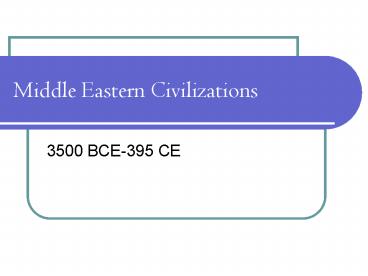Middle Eastern Civilizations - PowerPoint PPT Presentation
1 / 9
Title:
Middle Eastern Civilizations
Description:
Middle Eastern Civilizations 3500 BCE-395 CE Mesopotamia One of the world s great civilizations developed along mighty river systems in Mesopotamia. – PowerPoint PPT presentation
Number of Views:93
Avg rating:3.0/5.0
Title: Middle Eastern Civilizations
1
Middle Eastern Civilizations
- 3500 BCE-395 CE
2
Mesopotamia
- One of the worlds great civilizations developed
along mighty river systems in Mesopotamia. - Mesopotamia dates around3500 BCE.
- The source of life for Mesopotamia was the
Tigris-Euphrates River system in Asia.
3
Mesopotamia
- Mesopotamians learned how to use their natural
environments to their advantage. They achieved
this by learning how to control the floodwaters
of the rivers, and how to work the rich soils
along the riverbanks. - A constant food supply in these areas allowed
these peoples to have more free time, and to
develop successful cities, marvelous temples, and
powerful empires.
4
Map of Mesopotamia
5
Mesopotamia Cradle of Civilization
- Located in the Tigris-Euphrates valley of present
day Iraq is the ancient Sumerian city-state of
Ur. - Ur was one of the great city-states (an
independent state consisting of a city and its
surrounding territory) of ancient Mesopotamia. - Ur was a highly sophisticated society with
soldiers, court servants, musicians, and a strong
belief in the afterlife.
6
The Land Between the Rivers
- The empires of Mesopotamia included Sumer,
Babylonia, Assyria, and Chaldea. - Mesopotamia was part of an area known as the
fertile crescent, which was the site of some of
the worlds first permanent farming villages.
7
Map of the Fertile Crescent
8
Land and Climate
- The land and climate of this region hardly seem
ideal for a thriving civilization. - The south was mainly a flat flood plain.
- Summers were very hot and dry with droughts that
could kill crops and cause famines. - Spring often was a time of flooding from the melt
waters from the nearby Zagros Mountains - Winter was often a time for sudden downpours that
turned the plains to mud.
9
Assignment
- With your elbow partner discuss and describe the
location of Mesopotamia and the features of the
surrounding area using todays notes and map. - Based on what you now know about the early
civilization of Mesopotamia, how would you
explain the benefits of farming in the fertile
crescent?







![READ[PDF] An Introduction to the Modern Middle East: History PowerPoint PPT Presentation](https://s3.amazonaws.com/images.powershow.com/10117900.th0.jpg?_=202409020510)























